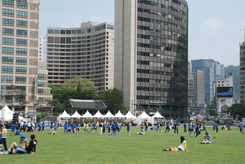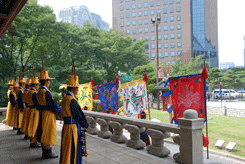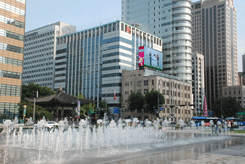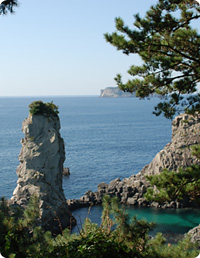WALKING
Seoul A / 5 hours



Tour Highlights
- Cheonggyecheon Stream
- Bosingak Bell Tower
- Insadong
- Jogyesa Temple
- Gwanghwamun Plaza
- Deoksugung Palace
- Namdaemun Market
- Myeongdong
Seoul (- - -)
You will explore Korea's capital city that is full of rich heritage, tradition, culture, history and tourist attractions.
The tour begins at Cheonggye Plaza, a 5.8km-long stream that flows through downtown Seoul. At the head of the stream stands a sculpture created by world-renowned artist Coosje Van Bruggen and Claes Oldenburg. Alongside the stream is a lively commercial district filled with numerous arcades and commercial facilities including the country's largest Dongdaemun Market.
Visitors stroll around the stream and lovebirds walk slowly arm-in-arm at night when the banks are lit up.
Bosingak bell tower sits at the busy intersection . A bell from 1468 was tolled here daily to announce the opening and closing of the city gates during the Joseon Dynasty (1392-1910). Today, the bell is tolled 33 times once a year at midnight on December 31. At this occasion, a large gathering of people celebrate and welcome the coming of New Year.
Insadong, at one time the center of traditional Korean art and antiques, features a mixture of historical and modern atmosphere representing the cultural glimpse of the nation. Clustered along the main street and alleys are lined with street vendors, wooden tea houses, restaurants and numerous galleries and shops dealing in antiques, oriental art supplies, and modern Korean art of all types and styles. Soak in the paintings, upscale artworks, antiques and potteries while you can. Get lucky and you just might meet the artist themselves. It can be plenty of fun walking on the main street, but you venture into the hidden alleys that do spring some unexpected surprises. While here, you may want to buy some souvenirs or simply wander and browse at leisure admiring cultural ambience.
A block away from the alley is Jogyesa, the head temple of Jogyejong, the principal sect of Buddhism in Korea emphasizing the Zen orthodox, meditation tradition and the purity of monastic celibacy. The temple does not give off the solemn and traditional air of the other temples located deep in the mountains, but when you enter the temple the frenzy of the city start disappearing. The Main Worship Hall, Daeungjeon, holds triad Buddhas, Sakyamuni, Amitabha and Bhaisajyaraja. The figure in the center is Sakyamuni Buddha who has overcome greed, hatred and delusion. While here it is worth noting the 500 year old lacebark pine and 400 year old locust tree that still grace the property.
Enjoy a stop at pedestrian-friendly Gwanghwamun Plaza that is hemmed in on both sides by rushing traffic and office buildings. The plaza is lined on each side with 365m long streamlets, two centimeters deep and one meter across, the stone bed of the plaza's east side waterway engraved with important events in chronological order from 1392 to 2008. Standing high on a stone pillar is a statue of Yi Sunsin who had engaged in twenty-three naval battles and emerged victorious in all of them during the Hideyoshi invasion (1592-1598). King Sejong who propagated the Korean alphabet in the 15th century is also honored with prominent statue. On August 16, 2014, Pope Francis celebrated Mass in this plaza to beatify 124 Korean martyrs. Near the southwest corner of the plaza is Korea's Kilometer Zero, marking the distances to 64 cities around the world, including Seoul's antipode, Montevideo, Uruguay, 19,606km.
Then, on to Deoksugung palace or Palace of Virtue and Longevity which was constructed as a private residence of the royal family. With the destruction of Gyeongbok palace by Hideyoshi's invasion in the late 16th century, it was used as a palace. Attractions include audience hall rebuilt, art gallery, Chunmyeongjeon the King Gojong's residences, inner palace residences, a bell cast in 1306 to honor Queen of first king of Joseon dynasty and statue of King Sejong who invented Korean Alphabet Hangul in 1443.
You will then explore the centuries-old Namdaemun Market brimming with well over 11,000 shops selling anything you can imagine. The whole area is a labyrinth of street vendors and buildings. The market is seriously crowded, so be prepared to get bumped around. A fantastic place to haggle over the price to get the best deal on something you want or simply admire the vibrancy of this massive market.
At the western entrance of the market in the middle of a traffic circle stands Sungnyemun. It is a formidable and iconic construct that served as the southern gate of the wall that surrounded Seoul during the period of the Joseon Dynasty.
Then, head on to Myeongdong, a famous fashion and shopping district filled with boutiques, cafes and swanky shops that sell clothes and accessories, allowing you to explore it at your own. Myeongdong's narrwow alleys packed with thousands of shops. Of the most notable attraction here is the Gothic style Myeongdong cathedral. It was built in 1898 and serves as the administrative seat of the Catholic church in Korea. The Bank of Korea and Central Post Office are on your way to Myeongdong.






